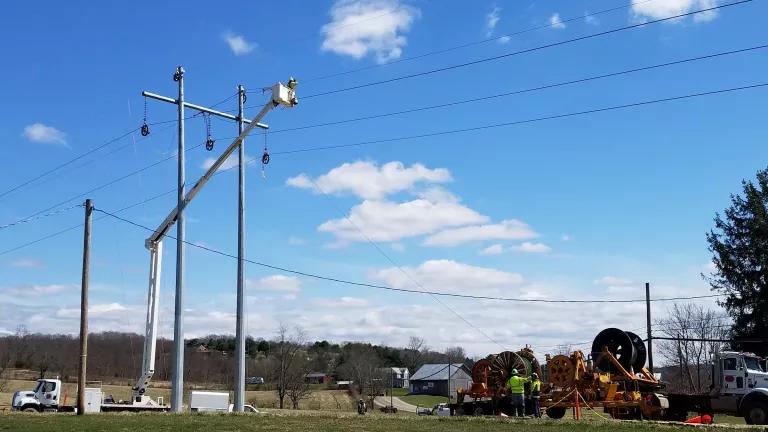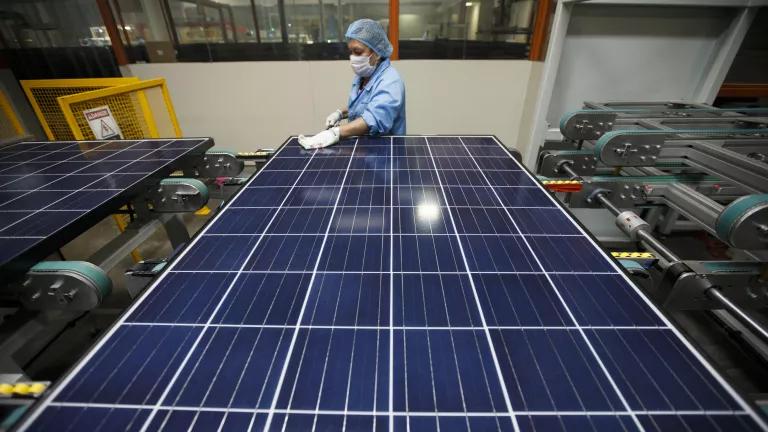Report Recommends Improvements for State-Level Renewable Energy Siting
NRDC, along with Clean Air Task Force and the Nature Conservancy, jointly commissioned E3 to assess siting and permitting policies for renewable energy development and identify solutions.

Solar panel arrays on a solar farm in Ohio
Nicholas Smith/Getty Images
This blog was co-authored with Nelson Falkenburg (Clean Air Task Force) and Jessica Wilkinson (The Nature Conservancy).
Rapidly accelerating the deployment of renewable energy projects is paramount for the United States to meet its climate goal of achieving net zero by 2050. NRDC, Clean Air Task Force, and the Nature Conservancy recognize that this deployment will only succeed if we minimize impacts to natural and working lands, ensure equitable benefit sharing, and address communities’ concerns about renewable energy impacts.
Cost and technical constraints were once the main challenges to building renewable energy projects. Now, institutional barriers like lengthy project permitting and approval processes and social barriers like local opposition make it increasingly difficult to execute projects at the speed and scale necessary to address climate change. New policies are urgently needed to address these barriers by supporting communities, expediting siting and permitting processes, and protecting valuable land resources when developing renewable clean energy.
That’s why our three organizations jointly commissioned E3, an energy and environmental economics consulting firm, to assess siting and permitting policies for renewable energy development and recommend policy solutions. Informed by qualitative and quantitative research, including interviews with 15 renewable energy siting stakeholders,[1]E3’s new report provides key considerations and best practices to accelerate permitting processes while minimizing environmental impacts and maximizing social benefits.
States have pursued a variety of approaches to site and approve renewable energy projects. In this report, E3 evaluated the different policy frameworks in eight states: California, Illinois, Indiana, Maine, New York, Ohio, Virginia, and Washington. While these states exhibit a range of renewable resource potential and levels of renewable deployment, they also vary in their permitting policy structures. For example, California, Illinois, New York, and Washington have increased state authority over renewable energy permitting in recent years. In contrast, states like Ohio have granted local jurisdictions more control.
In its report, E3 makes the following recommendations for policy interventions to facilitate more effective renewable energy permitting and siting:
- Increase permitting efficiency through a centralized "one-stop shop" for permitting to eliminate patchwork approaches involving multiple agencies with minimal coordination.
- Limit uncertainty in permitting decisions by implementing standardized requirements for all projects and predictable methods for evaluating site-specific conditions, reducing development risk.
- Require robust community engagement processes by including clearly defined periods of stakeholder and community involvement, during which local input is solicited and incorporated into siting and project design.
- Preempt unreasonably burdensome local ordinances by exercising state authority to set parameters and standards applicable to renewable energy.
- Create streamlined and transparent permitting timelines for timely review and approval.
In addition to these policy interventions, E3 recommends the following best practices:
- Promote early engagement between permitting authorities and developers to facilitate the timely identification of potential issues and give greater opportunity to amend project siting and design.
- Involve trusted third-party voices, such as local universities or state agricultural agencies, to provide educational and advisory resources to help local stakeholders develop informed positions about proposed projects, fostering community understanding and support.
- Encourage robust early and continuing community engagement between developers and local communities on siting and design, with time to address concerns and ensure project alignment with community needs and preferences. Ongoing communication and reporting on benefits of a project throughout its life cycle will further enhance community engagement.
- Apply agricultural land use best practices, with renewable developers adhering to third-party guidelines regarding land stewardship best practices. This will ensure that project sites can be restored for agricultural use after decommissioning, thereby minimizing the long-term impact on agricultural lands.
E3’s policy recommendations and best practices can help state and local governments reduce permitting timelines and uncertainty by steering renewable energy development toward sites that maximize benefits to communities while minimizing impacts to nature, thereby accelerating the permitting process. With thoughtful state siting policies and robust community engagement, the United States can achieve its climate goals while benefiting conservation and communities.
To learn more, read the full report here.
[1]Interviewees included state and local permitting staff, renewable energy developers, permitting lawyers and consultants, nonprofits, renewable energy advocacy organizations, and trade associations.




